Former General Electric Chairman and CEO, Jack Welch, notably stated that “an organization’s ability to learn, and translate that learning into action rapidly, is the ultimate competitive advantage.”
To drive consistent business growth and performance, the strategy and goal-setting process must take into account the changes in the business environment. The process of business strategy development and execution are advancing at a faster rate than previously. As companies strive to stay agile and adaptable quarterly plans are replacing one-year goal-setting methodologies.
The critical components of business strategy development are the mission statement, vision, strategy, goals, and objectives. While the definitions of these terms may have different and overlapping meanings, only by defining and differentiating them can you ensure successful business strategy development.
🚀Mission Statement = The purpose of your company and the reason why it exists
🔭Vision = The long-term directional statement (2-5 years) that describes what your company aspires to become to fulfill the mission
📑 Strategy = The long-term future direction you want your business to take
🎯 Goals = The focus areas that emphasize what you want to achieve
👉 Learn more about the different definitions and business terminology to bring clarity to your goal-setting process and ensure successful business strategy development.
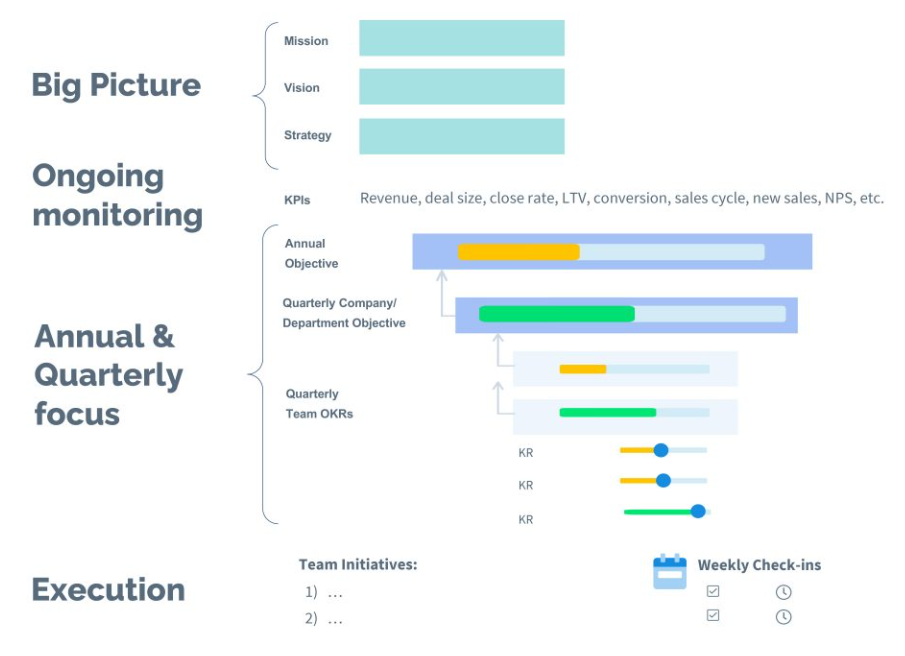
If you have already defined your company strategy, find out how using a dedicated OKR software can help you roll out your strategy to derive optimal business results.
Using a strategic approach to developing business strategy and goal-setting can help you stay agile and drive the resilience required to succeed. This article covers five tips you can use to develop an effective business strategy.
5 Tips for Effective Business Strategy Development
1. Identify the Vision and Aspirations of Your Business
Traditional goal-setting in business allows you to measure what you do, but it doesn’t lend itself to evaluating how or why you do it. Additionally, if you solely pay attention to the outputs, you can be tempted to make decisions that may not have an impact on business growth.
When developing business strategies consider setting and anchoring your goals to the vision of your business. This will motivate you and everyone in the company to focus more on your purpose and process rather than just your outputs. Once you have created a company goal, you can translate that to team objectives and align efforts toward achieving the overarching vision and mission.
The process of developing new business strategies begins with asking the right questions. 👉
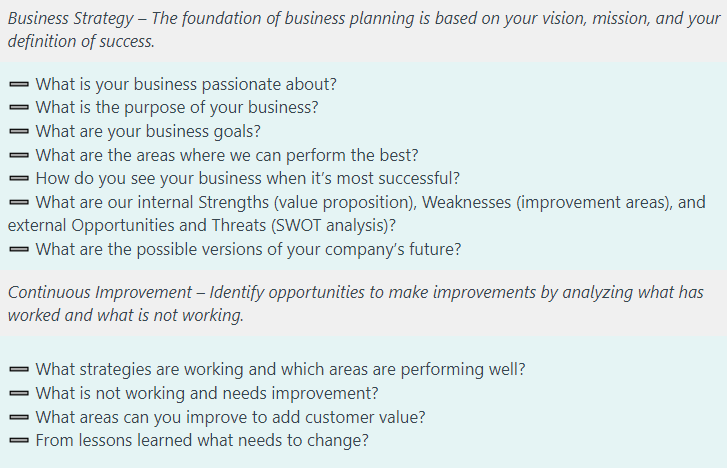
💡 If you are ready to develop a business strategy and set your goals, get started easily with this OKR planning template
Try OKR Software 🎯
Set and track OKRs in Weekdone OKR software with built-in examples, guided OKR Wizard, color-coded tracking, and visual dashboards. Stay focused – achieve goals.
2. Define the Value Proposition and Competitive Advantage
Business strategy development is fundamentally about identifying your value proposition and how you can provide value to customers over your competitors. In a competitive business environment, where expectations of modern customers have become more demanding, companies need to differentiate and not imitate.
A company can set itself apart from competitors by developing an “accumulated advantage” that takes into account several factors such as product features, service offerings, and delivery methods.
👉 Want to stay competitive? Learn how you can Get Business Planning Right Using OKRs.
3. Set and Align Goals and Objectives
Once you have a clear vision for your company, the next step is to define goals. Consider what you want to achieve, then work backward to determine how to get there. Having business objectives will assist guide your strategy and the way each team works together to reach your objectives.
Start by setting company goals which are broad objectives that you want the company to achieve. Use the company objective as a guideline to develop team or departmental goals.
💡 Keep in mind that it is better to align than cascade goals.
While the company goal needs to be defined by leadership and top management teams, the objectives and goals of teams should be set by team managers and members. Once the teams have determined their objectives, they can get feedback from top management to ensure it is aligned with the mission and strategy of the company.
This combination of top-down and bottom-up feedback is a great way to ensure everyone is engaged in the goal-setting process and that the goals are realistic yet aspirational to drive business value.
💡 Keep in mind that it is better to align than cascade goals.
While the company goal needs to be defined by leadership and top management teams, the objectives and goals of teams should be set by team managers and members. Once the teams have determined their objectives, they can get feedback from top management to ensure it is aligned with the mission and strategy of the company.
This combination of top-down and bottom-up feedback is a great way to ensure everyone is engaged in the goal-setting process and that the goals are realistic yet aspirational to drive business value.
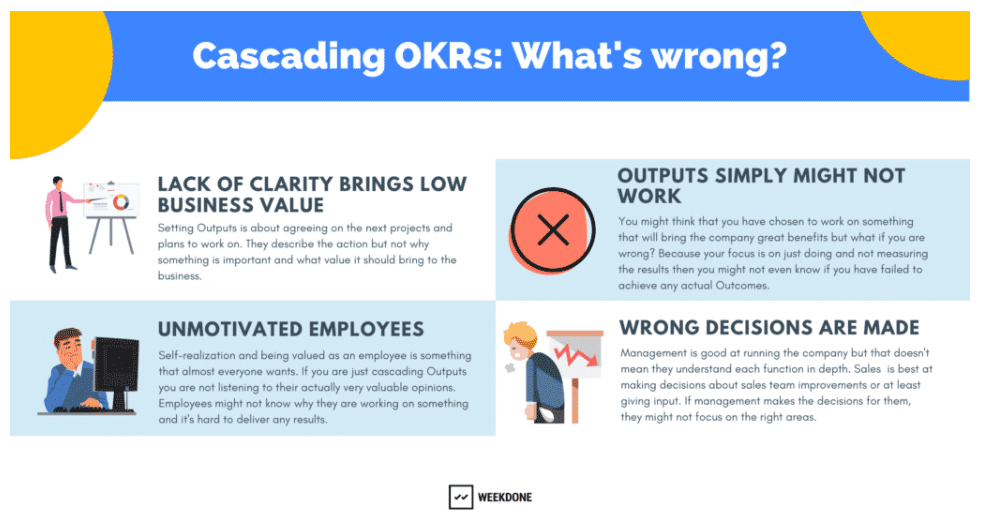
Try OKR Software 🎯
Set and track OKRs in Weekdone OKR software with built-in examples, guided OKR Wizard, color-coded tracking, and visual dashboards. Stay focused – achieve goals.
4. Communicate Strategy, Vision, and Goals
Every stakeholder and team member in a company must be informed of the company’s objective(s). Leadership and management teams need to take an effort to discuss the Objective and explain why a particular focus area is significant, or what kind of challenge it helps to solve.
Make sure to allow time for discussion and feedback. The Objective could be viewed differently by team managers. Find out their point of view and proceed to the next step only after everyone has agreed to work toward those goals. When teams working together do not understand or agree with the broad Objectives, it can become challenging to align teams and individuals and motivate them to work toward achieving the company’s mission.
💡 An effective way to develop an overall business strategy is to record your mission, vision, and goals in one place. You can use this business goals template to clearly articulate your goals, define your focus, and set measurable objectives. 👉
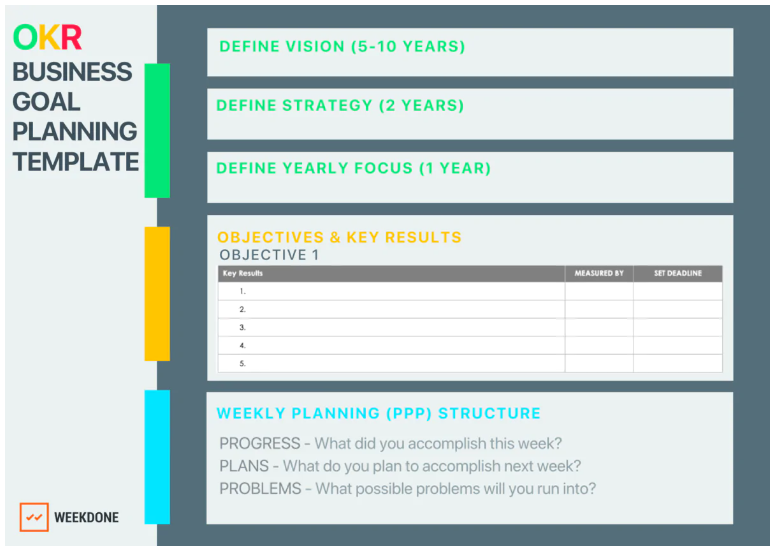
5. Make A Plan and Set Measurable Outcomes
For strategy execution to be successful, a specific action plan and measurable results need to be set. A business strategy must include specific steps required to carry out the purpose or achieve the goal, as well as tasks or initiatives that your team needs to perform.
Business strategies include directional goals which need to be broken down into strategic objectives. These objectives typically answer questions such as “What direction do we want to take”, “Where do we want to go,” and “Where do we want to be in the future”.
Business strategies include directional goals which need to be broken down into strategic objectives. These objectives typically answer questions such as “What direction do we want to take”, “Where do we want to go,” and “Where do we want to be in the future”.
Whether you choose to create long-term (1+ year) or short-term (3 months or less) business goals (examples below), ensure that they are time-specific and have measurable outcomes, Key Performance Indicators (KPIs), and Key Results (KRs).
Setting Key Results can help you assess the progress made toward your business objectives and identify new improvement areas to drive continuous growth. The best practice is setting key results that are specific, actionable, measurable, and achievable.
👉 Read more to find out how to set good Key results and the common mistakes you can avoid.
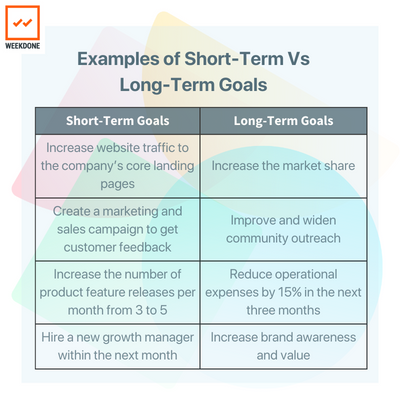
Try OKR Software 🎯
Set and track OKRs in Weekdone OKR software with built-in examples, guided OKR Wizard, color-coded tracking, and visual dashboards. Stay focused – achieve goals.
How OKRs Help Rethink Business Strategy Development
To thrive in a competitive business environment it has become important to innovate, plan strategically, and set goals with agility. Best-in-class companies with the philosophy of ”fail fast, learn faster” are increasingly adopting the OKR (Objectives and Key Results) framework.
The quarterly goal-setting OKR methodology has proven to work well for companies looking to redefine success and revamp strategies with agility. Because goals are updated quarterly, plans are created monthly, initiatives are reviewed weekly, and a goal-setting mindset is inculcated to drive growth in uncertain times.
The OKR methodology supports the business strategy development process by helping companies redefine their purpose of planning, the definition of success, and how goals are aligned and achieved. It can be easy to lose focus on what matters the most. OKRs can help to discover improvement areas faster and drive the focus on impactful business objectives.
Find out how using OKR software can help you roll out your company strategy and derive optimal business results.